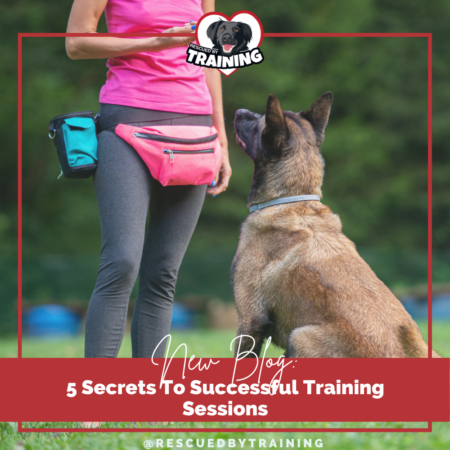Are you ready to set you and your dog up for successful training sessions? Here’s 5 secrets to help make your training sessions the most effective and efficient they can be.
- Keep your sessions short. For basic skills, try to train in 10-15 minute blocks. If you have a small dog, you may need to keep to 5-10 minute sessions. This helps keep your dog’s motivation and interest high. Always keep them wanting more. If you’re working with a fearful dog, they will determine how long the sessions should be. Always move at your dog’s pace. Fearful dogs may only be able to train for a couple of minutes. Be sure to watch body language and stop training at any sign of stress. Grab your free copy of my dog communication handout here.
- Prepare your food ahead of time. Prep your food (cooking it, cutting it up, bagging it, etc.) several hours or days in advance. We don’t want the act of food prep to be a tip-off to the dog that training is about to happen. This is especially important if you’re working with a fearful dog and we’re working on counterconditioning, to teach the dog one thing reliably predicts something good.
- Control the environment. Training in a low distraction environment and gradually making it more difficult over time (often weeks or months) is critical. If we start and the environment is too challenging, the dog will not succeed, won’t learn what we’re trying to teach and that will be frustrating for you too.
- Use a treat pouch. Having your high value food easily accessible during training sessions will allow for faster delivery and better timing. But, just like your food prep, don’t let it become a predictor of your training. Wear it around, make it part of your wardrobe so your dog doesn’t think “oh boy, I love when that little pouch comes out, I’m about to get some chicken!”
- Use a harness and long line. These two things can help reduce unintended leash pressure, give the dog more length to “vote with their feet” by giving them the choice to move away from scary things and ensure the dog doesn’t have any fallout associations like they might get if they were on a collar and short leash.
For more of my favorite training gear suggestions, download my free Dog Trainer’s Toolkit here. There are a lot of ways to manage and prevent problem behaviors so that our dogs stop practicing doing the wrong thing, right away. And my Toolkit gives you my favorite choices.
Book today! Grab your one on one session with me today!
And, be sure to sign up for my free weekly newsletter so you don’t miss out on free tips, videos, personal stories, client successes and more!
Happy training!
![]()




